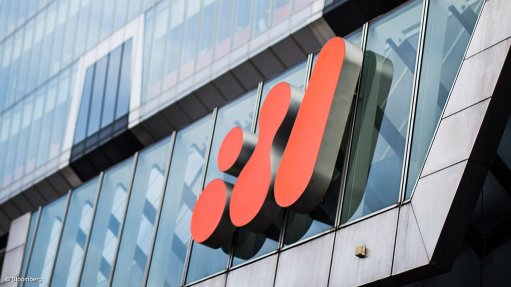
Photo by: Bloombeg
PERTH (miningweekly.com) – Mining major BHP Billiton on Wednesday reported record iron-ore production for the three months to September 30, as its Pilbara operations benefited from the ramp-up of the Jumblebar mining hub and improved ore handling at the Newman operation.
Iron-ore production rose 2% quarter-on-quarter to 61.3-million tonnes.
For 2016, the iron-ore operations were expected to produce some 247-million tonnes, but BHP was planning to increase output from its Western Australian operations to some 270-million tonnes, with better productivity the sole source of the volume growth.
Meanwhile, the miner reported a 2% increase in petroleum production to 64.5-million barrels of oil equivalent for the quarter under review. Onshore US liquids volumes for the quarter rose by 17% compared with the previous corresponding period, to 13.5-million barrels of oil equivalent, underpinned by continued momentum at the Black Hawk and Permian operations, where liquid production increased by 25% and 103% respectively.
However, compared with the June quarter, liquids production at Black Hawk and Permian declined by 17%, reflecting a lower capital spend.
BHP has flagged another $200-million reduction in capital expenditure (capex) for its petroleum division for the 2016 financial year, taking it from the initially planned $3.1-billion to $2.9-billion.
“In petroleum, we continue to reduce costs in both our onshore US and conventional businesses and will meet our production targets with $200-million less capital investment,” said BHP CEO Andrew Mackenzie.
Conventional capex was expected to account for some $1.5-billion of the spend and would remain focused on high-return infill drilling opportunities in the Gulf of Mexico and Australia, as well as life extension projects at Bass Strait and North West Shelf.
A further $1.4-billion would be spent on the onshore US assets.
Despite the decline in capex for its petroleum operations, BHP has maintained its full-year guidance of 237-million barrels of oil equivalent.
Meanwhile, copper production declined by 13% quarter-on-quarter to 230 000 t for the three months under review, as strong operating performance across the business was offset by grade decline at the Escondida mine, in Chile.
Planned smelter maintenance at the Olympic Dam operation, in South Australia, saw copper production from the mine increase by 50% during the September quarter, to 55 000 t. An increase in production was anticipated in the 2016 financial year following a mill outage that impacted output in 2015.
For the full 2016, BHP expected to produce some 1.5-million tonnes of copper.
Metallurgical coal production for the quarter was down 8% quarter-on-quarter and energy coal production 7% lower quarter-on-quarter, to both reach a ten-million-tonne output during the September quarter.
At the Queensland coal operations, record production at the Duania and South Walker Creek mines was supported by an increase in the wash plant use and yield; however, this was offset by planned longwall moves at the Broadmeadow and Crinum mines and wash plant shutdowns at the Goonyella and Peak Downs mines.
Mining at the Crinum operation was expected to cease in the first quarter of the 2016 calendar year, as the mine approached the end of its economic reserve life.
Meanwhile, energy coal production from the Cerrejon mine continued to be constrained by drought conditions, although volumes for the quarter were slightly higher than the previous corresponding period, which had been affected by more severe weather. This was offset by a slight reduction in volumes from the New South Wales energy coal division, owing to lower yield.
The metallurgical and energy coal divisions were expected to produce 40-million tonnes each for the 2016 financial year.